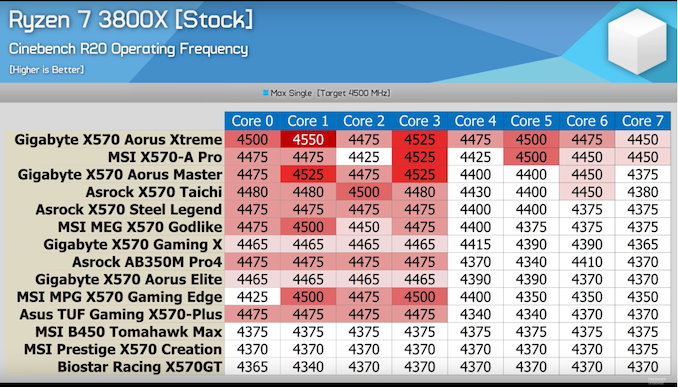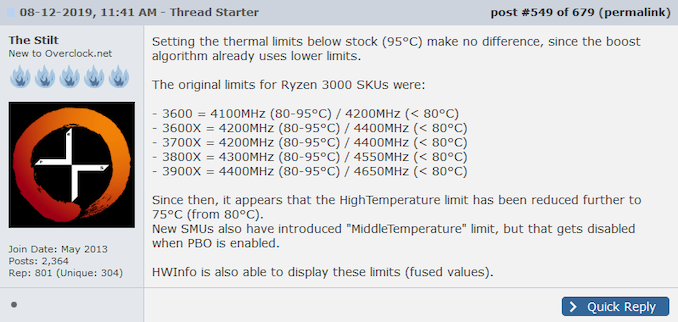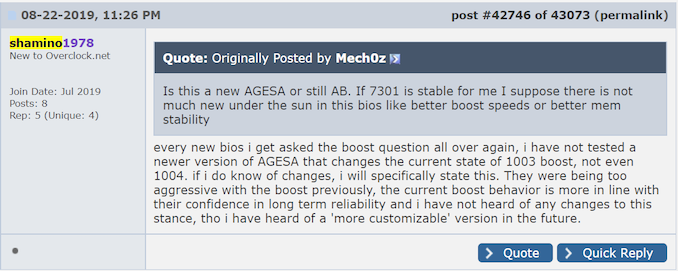Reaching for Turbo: Aligning Perception with AMD’s Frequency Metrics
by Dr. Ian Cutress on September 17, 2019 10:00 AM ESTAMD’s Turbo Issue (Abridged)
So why all this talk about how each company does its Turbo functionality, as well as its binning strategy? I prepped this story with the differences because a lot of our user base still thinks in terms of Intel’s way of doing things. Now that AMD is in the game and carving its own path, it’s important to understand AMD’s strategy in the context of the products coming out.
With that in mind, let’s cover AMD’s recent news.
Ever since the launch of Zen 2 and the Ryzen 3000 series CPUs, AMD has done its usual of advertising core counts, base frequency, TDP, and turbo frequencies. What has occurred since initial launch day reviews and through the public availability has been that groups of enthusiast users, looking to get the most out of their new shiny hardware, have reported that their processors are not hitting the turbo frequencies.
If a processor had a guaranteed 4.4 GHz turbo frequency, users were complaining that their peak turbo frequencies observed were 25-100 MHz less, or in some cases more than 100 MHz down on what was advertised. This kind of drop in frequency was being roughly reported through the ecosystem, but no-one particularly acted on it until these past few weeks, around the same time that AMD had several other news stories going on.
Multiple outlets, such as Hardware Unboxed, noted that the frequencies they were seeing significantly depended on the motherboard used. Hardware Unboxed tested 14 different AMD AM4 motherboards (some X570, others not X570) with a Ryzen 7 3800X, expecting a peak turbo frequency during Cinebench R20 of 4.5 GHz. Only one motherboard was consistent across most CPUs, while a few others were hit and miss.
This obviously plays into some reasoning that the turbo is motherboard dependent, all else being equal. It should be noted that there’s no guarantee that all these motherboards, despite being on the latest BIOSes, actually had AMD’s latest firmware versions in place.
Another outlet, Gamers Nexus, also observed that they could guarantee a CPU would hit its rated turbo speeds when the system was under some form of cold, either chilled water or a sub-zero cooling environment. This ultimately would lead some believe that this relates to a thermal capacity issue within the motherboard, CPU, or power delivery.
The Stilt, a popular user commonly associated with AMD’s hardware and its foibles, posted on 8/12 that AMD had reduced its peak temperature value for the Ryzen 3000 CPUs, and had introduced a middle temperature value to help guide the turbo. These values would be part of the SMU, or System Management Unit, that helps control turbo functionality.
Peter Tan, aka Shamino, a world renowned (retired) overclocker and senior engineer for ASUS’ motherboard division, acknowledged the issue in a forum post on 8/22 with his own take on the matter. He stated that AMD’s initial outlay with its turbo boost behavior was ultimately too aggressive, and in order to ensure longevity of the chip, the boost behavior was in line with what AMD needed to achieve that longevity.
It should be stated here that Shamino is speaking here in his personal capacity.
For those not engrained in the minutae of forum life, the biggest arrow to this issue came from Roman Hartung, or Der8auer, through his YouTube channel. He enlisted the help of his audience to tabulate what frequencies users were getting.
In the survey, the following details were requested:
- CPU
- Motherboard
- AGESA version/BIOS version
- PBO disabled
- Air cooling
Now obviously when it was announced that this survey was going to happen, Roman and AMD discussed behind the scenes the pros and cons about this survey. As you might expect, AMD had some reservations that this survey was in any way going to be fair – it’s about as unscientific as you can get. Naturally Roman argued that these would be real world results with users machines, rather than in-lab results, and AMD should be guaranteeing users on their home machines with specific frequency values. AMD also pointed out that with this sort of survey, you have an inherent selection bias: users who feel negatively impacted by any issue (through AMD’s fault or the users own) are more likely to respond than those that were happy with the performance. Roman agreed that this would be a concern, but still highlighted the fact that users shouldn’t be having these issues in the first place. AMD also mentioned that the Windows version couldn’t be controlled, to which Roman argued that if turbo is only valid for a certain Windows version, then it’s not fair to promote it, however did concede that the best performance was the latest version of Windows 10, and users on Windows 7 will have to accept some level of reduced performance.
Roman and AMD did at least agree on a testing scenario in order to standardize the reporting. Based on AMD’s recommendations, Roman requested from his audience that they use CineBench R15 as a single threaded load, and HWiNFO as the reporting tool, set to a 500 millisecond (0.5 second) polling interval, with the peak frequency from the CPU listed.
The survey ended up with ~3300 valid submissions, which Roman checked one-by-one to make sure all the data was present, screenshots showed the right values, and removed any data points that didn’t pass the testing conditions (such as PBO enabled). The results are explained in Roman’s video and the video is well worth a look. I’ve summarized the data for each CPU here.
| Der8auer's Ryzen Turbo Survey Results | |||||
| AnandTech | 3600 | 3600X | 3700X | 3800X | 3900X |
| Rated Turbo MHz of CPU | 4200 | 4400 | 4400 | 4500 | 4600 |
| Average Survey MHz | 4158 | 4320 | 4345 | 4450 | 4475 |
| Mode Survey MHz* | 4200 | 4350 | 4375 | 4475 | 4525 |
| Total Results Submitted | 568 | 190 | 1087 | 159 | 722 |
| # Results Minus Outliers | 542 | 180 | 1036 | 150 | 685 |
| Results >= Rated Turbo | 210 | 17 | 153 | 39 | 38 |
| % Results >= Rated Turbo | 50% | 9% | 15% | 26% | 6% |
| *Mode = most frequent result | |||||
I have corrected a couple of Roman’s calculations based on the video data, but they were minor changes.
For each CPU, we have the listed turbo frequency, the average turbo frequency from the survey, and the modal CPU frequency (i.e. the most frequently reported frequency). Beyond this, the number of users that reported a frequency equal to the turbo frequency or higher is listed as a percentage.
On the positive, the modal reported CPU frequency for almost all chips (except the 3900X) is relatively close, showing that most users are within 25-50 MHz of the advertised peak turbo frequency. The downside is that the actual number of users achieving the rated turbo is quite low. Aside from the Ryzen 5 3600, which is 50%, all the other CPUs struggle to see rated turbo speeds on the box.
As you might imagine, this data caused quite a stir in the community, and a number of vocal users who had invested hard earned money into their systems were agonizingly frustrated that they were not seeing the numbers that the box promised.
Before covering AMD’s response, I want to discuss frequency monitoring tools, turbo times, and the inherent issues with the Observer Effect. There’s also the issue of how long does turbo need to be active for it to count (or even register in software).













144 Comments
View All Comments
0siris - Tuesday, September 17, 2019 - link
In the end, this doesn't change anything for those of us who read reviews and decided based on those if the performance in our workloads was acceptable for the price AMD was asking. But if your marketing is going to dumb the performance down to a (set of) number(s), then you will also have to deal with the complaints of people whose understanding doesn't go beyond those simple numbers. Looks like the "bigger number!" marketing we've seen with is finally starting to hurt companies.It seems completely logical to me that boosting algorithms will become ever more refined to ensure optimal performance at all times. That's a good thing for all of us.
WaltC - Tuesday, September 17, 2019 - link
The so-called Bulldozer lawsuit was settled by the lawyers who brought the suit (not just by AMD, as is erroneously often implied), who agreed to take the money and run rather than chance the loss of their suit, ultimately, because AMD surely would have won, anyway. AMD agreed to the payout as it amounted to less money than it would have cost AMD to actually go all the way and win the suit--this is why companies settle spurious lawsuits--and is the only reason they do. Additionally, in writing, the suing attorney's agreed with AMD that AMD had done nothing wrong--no false advertising, etc. Whenever this "issue" *cough* is raised, it is never explained fully--with a sort of mindless "AMD did something wrong" emphasis. Of course, nothing about this *old* lawsuit has anything at all to do with the burst frequency issue which AMD recently corrected in the ABBA AGESA is distributed a week ago--so what is the purpose of mentioning a lawsuit that the suing attorney's have dropped and agreed with AMD that AMD had done nothing wrong?....;) Clearly, the suing attorneys believed they could not win, else they would not have agreed to such a tiny settlement, eh? Or agreed to signing a statement clearing AMD of any wrongdoing whatsoever. (There is something wrong with the civil system when this kind of garbage is allowed to clog up the courts, imo, but that's another issue entirely.)I really don't understand why some people don't understand that "teething" issues with a new architecture release are common--and it doesn't matter whether AMD makes the CPU or Intel makes it--new architectures all demand a period of software adjustment--six months to a year is common for both companies when new architectures are released! I marvel that this needs explanation...;) It's been so long since Intel has shipped a ground-up new architecture, though, that likely few remember Intel-architecture teething problems. I hate to see all the red faces appearing when and if Intel ever makes it to 7nm with a new architecture....)
AMD has also made it clear that the AGESA bugs caused the loss of boost MHz, in all cases. They've surely fixed it--my 3600X boosts now like it did with AGESAs 1002/3 in bios releases for my x570Arus Master--and a tad faster--to 4.424GHz, instead of 4.401GHz. (Wowee...;)) Later AGESAs up through ABB cut max boost by ~125Mhz. Happy to report that has been remedied with the newer AMD AGESA ABBA bios for my x570 Master.
hansmuff - Tuesday, September 17, 2019 - link
Outrage culture and the lawyers are just cashing in on it. Can't blame them either.WaltC - Tuesday, September 17, 2019 - link
Yes! I really don't blame the starving lawyers quite as much as I blame the judges who greenlight spurious stuff like this. I mean, it creates the impression that either the judges don't understand the issues involved, or else that it's a racket with "everyone" hoping to share the ill-gotten gains...;) Because in the end--it's we the customers who pay for all of the spurious junk that isn't thrown out on day 1--just as much as if it was a direct tax. This reminds me so much of the infamous class-action suit they tried and failed to throw at the HDD makers a few years back. The lawyers alleged that everyone who bought a hard drive was "mislead" by false advertising because the HDD makers decided to call a "megabyte" 1,000,000 bytes instead of 1,024,000 bytes--*even though* all of the HDD makers posted that information not only in all their product advertising, but also on the HDD product boxes! The judge in that case was savvy enough to throw it out on Day 1, IIRC. In the Bulldozer case, of course, the lawyers will earn $6M-$8M (or more) of the $12M and the Bulldozer owners might be lucky to get $10 each....;) What a racket!...;)Targon - Tuesday, September 17, 2019 - link
Intel hasn't had a new architecture for so long at this point, many people have forgotten about the problems.WaltC - Tuesday, September 17, 2019 - link
Shades of Prescott..;)Korguz - Tuesday, September 17, 2019 - link
Targon, not according to one person that comments on here, sunny cove is a new architecture, and is completely different then all the cpu's intel has made over the last 5 or so years.but yea.. its time intel stopped milking the same architecture, and its customers, and came out with something that is actually new
Phynaz - Wednesday, September 18, 2019 - link
Why do you care, you would never buy intel?FunBunny2 - Wednesday, September 18, 2019 - link
"its time intel stopped milking the same architecture, and its customers, and came out with something that is actually new"'architecture' is constrained by the Law's of God, aka maths, so once the 'best' has been found, that's it. IMHO, all these 'architectures' amount to:
1) pulling previously off-chip function on-chip
2) rearranging them to implement Cray's shorter wires
3) adding more transistors to make certain functions bigger
not really much 'architecture' progress to any of that. in any case, how much more 'architecture' does it take to do word processing, spreadsheets, and e-mail? you know, the Three Killer Apps of the PC?
Korguz - Wednesday, September 18, 2019 - link
once the best has been found ??? intel hasnt released a new architecture because they have had no reason to. but i bet now, with Zen, intel is doing just that, working on something that is actually new and not based on the same cpu we have had from them for the last 5 or so years.